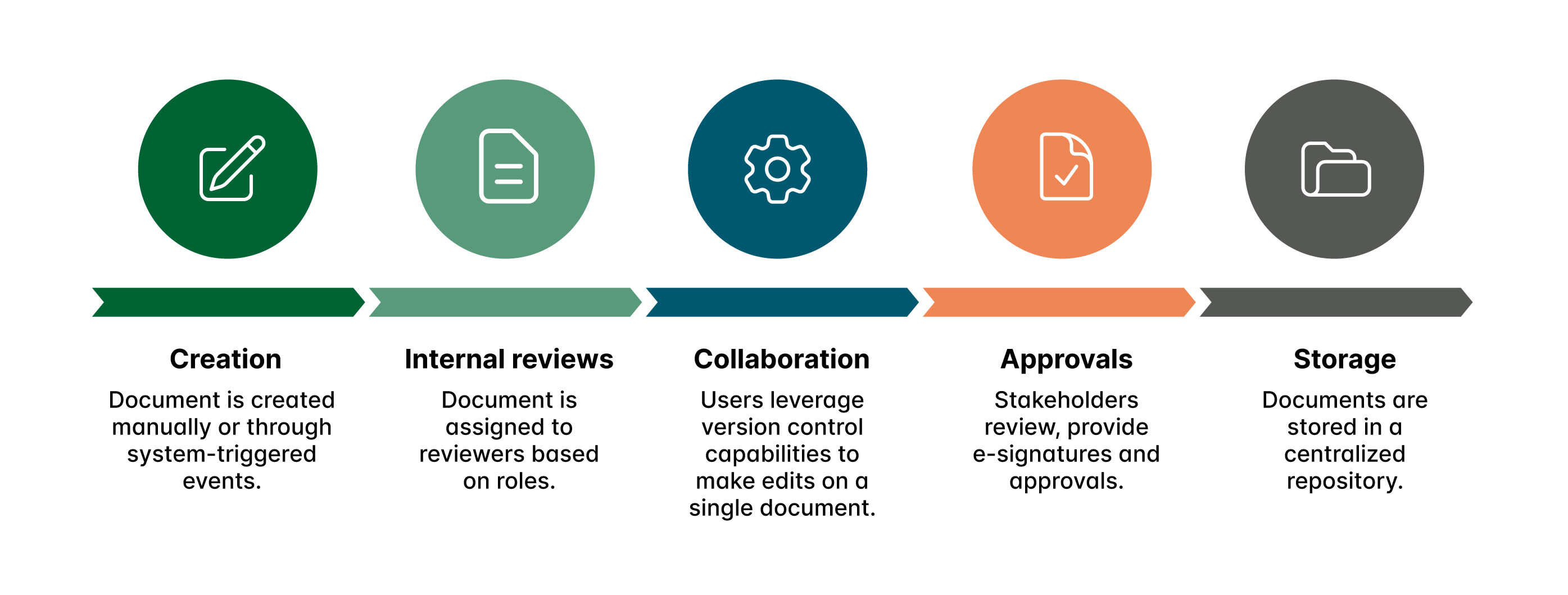How to implement and manage document workflow automation
Understand the fundamentals of document workflow automation and how it streamlines file reviews, edits and approvals enterprise-wide.
Understand the fundamentals of document workflow automation and how it streamlines file reviews, edits and approvals enterprise-wide.

Organizations of all sizes can turn to document workflow automation to reduce file reviews, approvals, edits and storage. The more data and content you manage, the more important it is that you can implement and enforce a long-term document workflow automation strategy.
Document workflow automation uses technology to automate document-driven processes within an organization. It manages the process flow of documents from creation to distribution, collaboration, approval and storage.
By automating repetitive tasks, such as data entry and approval workflows, automated workflows free up valuable time for your employees to focus on strategic and creative areas of their work.

Here's a step-by-step breakdown to guide you through the automation process:
Begin with a detailed analysis of your current processes. Examine each step, note bottlenecks, understand where your employees' time is spent and identify specific processes that are prone to error. This highlights the inefficiencies that automation can resolve. Understanding the current situation provides groundwork for a streamlined and optimized workflow.
Assess the compatibility of potential solutions with your existing software and systems. You need to be able to connect this automation tool with your current project management infrastructure, CRM or enterprise resources planning platforms.
When you’re making your decision, factor in the scalability of this tool. Can it accommodate the growing complexity of your current and future document workflows? Consider how this may affect licensing fees, implementation and maintenance costs.
Once the automation tool is connected to your existing platform, it's time to design the workflow. Start by defining triggers, actions, conditions and necessary approvals.
The goal is to generate a digital representation of the workflow that replicates the steps involved in the manual process. This sets the rules that the automation tool will follow, ensuring a smooth transition from manual to automated operations.
Once the workflow has been digitally replicated and is a predictable process, robotic process automation (RPA) technology can be programmed to perform the actions that were previously done manually. Hyland RPA, for example, can automatically make decisions based on predefined rules.
Run the automated process several times under different scenarios to identify and fix any potential issues.
Testing ensures the automation tool operates accurately and effectively, delivering the desired outcome without creating new complications. Use this time to gather feedback from relevant business and make improvements to optimize the process.
If available, leverage the support and training options provided by your automation vendor. Fostering new habits while keeping a feedback loop going to address any potential automation concerns are the keys to paving the way for a successful implementation.
> Read more | The ultimate guide to enterprise automation
Auditor staff spent nearly six months each year processing more than 90,000 personal property tax returns. The manual effort tied up the workforce and limited other important tasks. Using Hyland RPA, Horry County automated tax return intake and used conditional business rules to tackle complexities. In year one, 30,000 returns were processed without human interaction, plus thousands more with limited oversight.
Automation of document workflows represents a paradigm shift in how businesses handle the challenges of document management. Here are some benefits of automated workflows:
Document workflow automation acts as an accelerator, reducing the time spent on manual tasks by creating a streamlined and automated process. This results in heightened productivity and significant cost savings as manual efforts are replaced with efficient, automated workflows.
A real-life example is the Colorado Housing and Finance Authority (CHFA), a state agency that facilitated quicker document access with Hyland’s OnBase platform. CHFA managed to automate several paper-intensive, manual processes and saved a grand total of $600,000 through faster file retrieval and better productivity alone.
Market data and business insights platform Gitnux show that data accuracy increases by 88% when organizations leverage workflow automation – higher than any other forms of document processing methods.
By automating data entry and document processing, your document management system could further minimize potential errors and inaccuracies. This creates a reliable and error-resistant repository of information, contributing to a higher level of trust and reducing the probability of costly mistakes.
> Learn more | How BPA software facilitates faster, more accurate outputs
Here are a few day-to-day examples of how automated document workflows work for different industries and departments:
This is what an automated document workflow for purchase refunds looks like:
Automation can transform patient record management by seamlessly handling patient charts, consent forms and insurance claims.
M Health Fairview, an integrated academic health system, receives about 9 million patient documents — many of which are physical documentation — that must be quickly classified for access and care decisions within their electronic health record (EHR).
They use Hyland’s Intelligent MedRecords (IMR), an intelligent capture, extraction and validation solution that automatically sorts paper and digital documents to drive the classified data into Hyland’s OnBase and their EHR. The automation project was able to automate the classification of 208 document types, workflow improvements a new data process capture server for the on-premises deployment.
Automated document management helps with the circulation of financial documents across various departments and stakeholders, ensuring that all relevant users can access and approve critical documents on time.
The American National Bank of Texas (ANBTX) needed to improve paper-heavy loan processing workflows, so the organization decided to automate loan onboarding, collateral tracking, insurance and escrow.
The team introduced a new Lean Six Sigma initiative to improve the nearly two-hour-per-day mortgage warehouse loan process. With Hyland’s workflow tools, this process now takes 20 minutes per day.
Document automation within an end-to-end contract lifecycle management (CLM) solution aims to manage and streamline business contracts that are compliant with relevant regulations.
For instance, upon receiving a contract request, the automated system can generate a draft contract using pre-existing templates. This draft can be reviewed and edited if necessary and then sent for approval.
The approval process can also be automated, with the contract being sent to everyone involved based on predetermined rules. Once approved, the contract can be executed, and the system will store it securely. The CLM system can then track key dates and milestones, sending reminders when renewals or other actions are needed.
Automation speeds up procedures, leading to quicker hiring and more efficient internal operations. This includes everything from policies and resumes to offer letters and employee onboarding.
This grocery store, with 17 locations across northeast Ohio, needed a way to scale its HR processes to manage growing volumes of employee data and files. After implementing workflow automation, the grocery chain managed to accelerate key HR processes like associate status changes, time-off requests and policy acknowledgments.
HR professionals could also manage extended leave requests from a 360-degree view of all relevant information tied to each request.
When a marketing campaign is triggered, your document management system can activate an automated document workflow based on the nature of the content request.
The draft document, after being worked on by relevant users in your marketing department, can be automatically sent to relevant stakeholders involved in this process (product managers, the legal team, etc.) to ensure that content adheres to company guidelines.
After receiving the necessary approvals, the promotional materials go live. If needed, the workflow could be configured to archive final campaign documents for future reference and campaign performance tracking post-publication.
Businesses can guarantee efficient procurement procedures by automating purchase orders and invoice approvals. This leads to improved vendor relationships, shorter processing times and greater procurement cycle efficiency. Document workflow automation can improve tasks such as:
Traditionally, when an IT-related problem arises, a service ticket is created manually and project managers assign this to the appropriate staff member.
With automated document workflow, when a ticket is logged, automated workflows use preset parameters (nature of the issue, the department it originates from, etc.) to assign the ticket to the most suitable IT staff member. All relevant screenshots, reports and other files tied to the request are provided to the assigned personnel — ensuring there are no costly delays and unnecessary paper-chasing.
By automating routine tasks such as document routing, legal professionals can free up time for critical thinking and building client relationships.
Upon receiving a new case, the system automatically assigns it to the appropriate legal professional based on preset parameters such as area of expertise and workload. This eliminates the need for manual case assignment and ensures a balanced distribution of work.

How should you choose the right automation tools for your organization’s needs and goals? Start with insights from advisory firm Deep Analysis, including types of automation tools and their differences, seven steps to deciding which automation tools to use and how leading companies approach their automation initiatives.
Automation is everywhere. It’s time to put it to work for you.
Automated document workflows ensure that every document undergoes a predetermined set of procedures, producing consistency while handling different types of documents.
This reduces the unpredictable factor frequently associated with manual processing and speeds up operations while creating a consistent and compliant document management system.
Collaboration becomes an agile and dynamic process with more automation around day-to-day document management. Ensure that your document management platform is powered up with version control capabilities so that all users have access to the latest version of a document.
You could also integrate e-signature tools to speed up safe, trackable and compliant digital acknowledgments and reduce unnecessary delays in business contract management processes.
A well-executed document workflow enforces accountability and transparency by recording who accessed, modified or approved a document.
With automated document workflows, organizations can decrease their risk of noncompliance and confidently produce audit trails.
As organizations handle larger volumes of documents, your document workflow automation tool should adapt seamlessly without requiring a rise in administrative costs.
This scalability guarantees the advantages of automation are consistent no matter how large a company becomes, offering flexibility in handling growing workloads.
Document workflow automation is a logical step to creating a future-proof, seamless document management strategy.
Its true potential comes to life when integrated with broader process automation, such as Hyland's RPA tool. By automating repetitive tasks using tools like Hyland RPA, organizations can redirect focus from mundane tasks to strategic initiatives.
Document workflow automation uses technology to streamline tasks. It eliminates manual data entry and approvals. Traditional document management relies on human intervention. Automation is faster and error-free, freeing up employees for strategic tasks.
Track time and cost savings. Measure error rate reductions. Compare metrics before and after automation. Gather employee feedback to assess improvements.
RPA uses software robots for repetitive tasks. It automates data entry and approvals. RPA reduces human intervention and handles complex workflows, enhancing automation.
Automation ensures version control and access to the latest documents. It routes documents efficiently for review and approval. E-signatures speed up the process. All stakeholders stay aligned

Hyperautomation is not just a buzzword but a reality that transforms the way organizations do everything from capturing and extracting data to deploying business applications.

A document storage system makes it easy for teams to collaborate on documents, even if they are working remotely or in different locations.